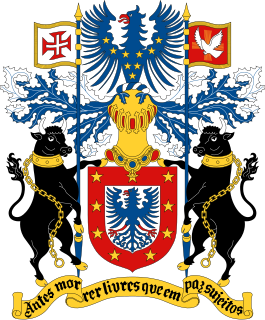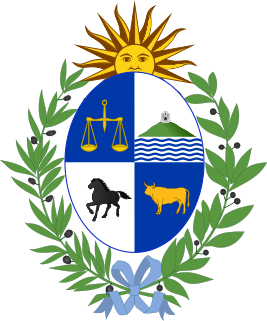 W
WThe coat of arms of the Municipality of Alba Iulia unites the traditional heraldic symbols of the three Romanian Principalities: Wallachia's golden eagle, Moldavia's black aurochs, and Transylvania's two lions rampant. In chief is the Crown of Romania on an ermine field.
 W
WThe coat of arms of Andorra is the heraldic device consisting of a shield divided quarterly by the arms of the Bishop of Urgell and the Count of Foix – who have historically been the two co-princes of Andorra – in addition to the emblems of Catalonia and the Viscount of Béarn. Utilized unofficially since the Middle Ages, its status as the coat of arms of the Principality of Andorra was formalized in 1993 upon the implementation of their new constitution. The escutcheon is featured on the flag of Andorra.
 W
WThe Great Seal of the State of Arizona. According to Article 22, Section 20 of the State of Arizona Constitution by the Arizona State Legislature:
 W
WThe coat of arms of the Azores is nine gold stars superimposed on a red bordure, representing the nine islands of the archipelago. The bordure surrounds a silver shield on which a blue eagle is displayed with wings elevated and with red feet, beak, and tongue. The crest is a closed helm in gold lined with red, surmounted by a wreath and mantling of silver and blue, topped by another blue eagle on which are superimposed the same nine gold stars.
 W
WThe coat of arms of South Africa between 1910 and 2000 was granted to the Union of South Africa by King George V and later amended by the British College of Arms. It contained representation of the four provinces within the Union. The coat of arms was later retained by the Republic of South Africa for a period until the end of apartheid in 1994. The 1910 coat of arms was replaced in 2000 by a more Africanised coat of arms of South Africa.
 W
WThe great seal of the state of Delaware was first adopted on January 17, 1777, with the current version being adopted April 29, 2004. It contains the state coat of arms surrounded by an inscription.
 W
WThe coat of arms of Focşani is the official heraldic arms of the Romanian city of Focşani.
 W
WThe coat of arms of Głogów depicts a shield divided crosswise into four fields, with a fifth central field on which there appears in the centre an initial golden "G" on a red background.
 W
WThe Great Seal of the State of Kansas tells the history of Kansas.
 W
WThe coat of arms of Lancaster University is the official emblem of Lancaster University, in Lancashire, England. It was granted to the university by Royal Charter on its establishment in 1964.
 W
WThe seal of Madagascar includes an outline map of the island at the center, and below it the head of a zebu. Colors used are red, green, yellow, black, and white. Green and red rays emanate from the map, making it look like the sun and also the Ravenala, a plant typical of Madagascar.
 W
WThe coat of arms of Moldova is the national emblem of the Republic of Moldova.
 W
WThe coat of arms of Niger shows a four-part flag draping in the national colors orange, white, and green. In the middle, the state seal is arranged. On a green or gold shield the four golden symbols are shown. In the middle, there is a sun, to the left there is a vertical spear with two crossed Tuareg swords, to the right are three pearl millet heads and underneath is the frontal view of a zebu head. Under the coat of arms, there is a ribbon bearing the name of the country in French: Republique du Niger. While the constitution of Niger stipulates the color of the symbols upon the shield, there is no uniformity on the color of the shield. The 1999 Constitution reproduces the text of earlier constitutions, making a distinction between the Seal of State for which no shield colour is stipulated and the Coat of Arms of the Republic for which Sinople is stipulated as the shield colour. Sinople is analogous to Vert (Green) in heraldry, but official buildings and documents do not display green shields. Embassies and official documents use white, with gold emblems. The website of the President of Niger uses gold or yellow with dark gold or black emblems. The National Assembly of Niger meets below a large coat of arms with the shield coloured gold and the emblems in a darker gold.
 W
WThe Seal of the State of Oregon is the official seal of the U.S. state of Oregon. It was designed by Harvey Gordon in 1857, two years before Oregon was admitted to the Union. The seal was preceded by the Salmon Seal of the Provisional Government and the Seal of the Oregon Territory. The state seal is mandated by Article VI of the Oregon Constitution.
 W
WThe coat of arms of Oxford is the official heraldic arms of Oxford, used by Oxford City Council.
 W
WThe coat of arms of Romania was adopted in the Romanian Parliament on 10 September 1992 as a representative coat of arms for Romania. It is based on the Lesser Coat of Arms of the Kingdom of Romania, redesigned by Victor Dima. As a central element, it shows a golden aquila holding a cross in its beak, and a mace and a sword in its claws. It also consists of the three colors which represent the colors of the national flag. The coat of arms was augmented on 11 July 2016 to add a representation of the Steel Crown of Romania.
 W
WThe Great Seal of the State of South Dakota was designed while the area was a territory, in 1885. The outer ring of the seal contains the text "State of South Dakota" on the top and "Great Seal" on the bottom. Also the year of statehood, 1889. Inside the inner circle of the seal contains the state motto "Under God the People Rule". The picture features hills, a river with a boat, a farmer, a mine, and cattle. The items in the image are to represent the state's commerce, agriculture, industry, and natural resources.
 W
WThe coat of arms of Uruguay or Uruguayan shield was first adopted by law on March 19, 1829, and later on had some minor modification in 1906 and 1908. It was supposedly designed by Juan Manuel Besnes Irigoyen (1788–1865).
 W
WThe coat of arms of Vermont is the official armorial bearings of the U.S. state of Vermont. Most of the elements found in the coat of arms originate in the Great Seal of Vermont designed by Ira Allen. Whereas the Great Seal of Vermont is reproduced in a single color and is reserved for embossing and authenticating state documents, the coat of arms is a more naturalistic and colorful representation of many of the same elements. The Coat of arms of Vermont was first used in 1807 on $5 bank notes of The Vermont State Bank. One of these notes is in the special collections of the Vermont History Center in Barre, Vermont. Prior to the discovery of the 1807 banknotes, the earliest representation of the coat of arms of Vermont was found on an engraved 1821 state military commissions. The exact designer is not known, but it is likely that then Secretary of State Robert Temple worked with an engraver in developing the arms. Considerable liberties were taken in early depictions of the coat of arms. The location of the cow and the sheaves moved about the foreground, and the height of the pine tree and size of the buck's head also varied. A state statute was approved in 1840, and modified in 1862, both attempts to codify and create more consistent representation of the arms. The coat of arms was cast in brass to ornament uniforms of Vermont's military regiments before, and through the U.S. Civil War, when individual states raised and trained their own regiments.
 W
WThe Great Seal of the State of West Virginia was adopted in September 1863. The obverse center of the seal contains a boulder that has been inscribed June 20, 1863, the date West Virginia became a state. In front of the boulder lie two crossed rifles and a liberty cap as a symbol of the state's fight for liberty. The two men on either side of the boulder represent agriculture and industry. On the left stands a farmer with an ax and plow before a cornstalk. On the other side stands a miner with a pickax, and behind him an anvil and sledge hammer. The outer ring contains the text "State of West Virginia" and the state's motto "Montani Semper Liberi",. The reverse of the seal, also called the lesser seal, is the official seal of the Governor. Its motto reads "Libertas E Fidelitate".